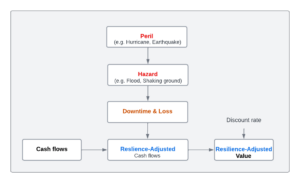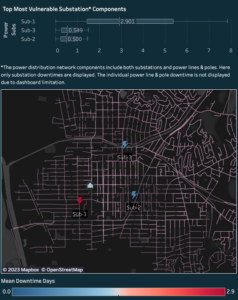MENLO PARK, CALIF. (July 14, 2023) — Traditional real-estate valuation methods, such as discounted cash flow (DCF) models, do not adequately account for costs associated with catastrophic events and their impact on a property’s net operating income (NOI) over a given time horizon. These DCF models, designed to predict likely future cash flows, fail to consider the potential loss in value due to either direct or indirect impairment from natural disasters.

In resilience-adjusted valuation and comprehensive risk quantification use cases, One Concern’s (1C) business downtime metrics effectively measure how a natural disaster could financially impact a property’s valuation. By introducing a resilience adjustment to the traditional cash flow predictions, 1C’s analytics account for various hazard-driven threats that could impair a commercial property’s ability to generate income. This adjustment uses an evidence-based approach, factoring in both the likelihood and severity of catastrophic events to reflect their impact on NOI over a specified period. This methodology bridges the gap in conventional models, offering a more comprehensive appraisal of a property’s value in the face of potential natural disasters.
One Concern’s Exceedance Probability (1CEP™) and related Downtime Statistics (1CDS™) consider the probability of property disruption and the expected recovery time after a natural disaster. Both direct and indirect impacts are quantified, including damage to the building and lifelines that support the operations of businesses in a given building (i.e., power outages, transportation disruption, port/airport closure, and road/bridge impairment). These statistics can be combined with a suitable loss function that accounts for how the possible downtimes lead to financial losses. Given the data from One Concern is available for every commercial asset in the U.S., it is possible to distinguish loss scenarios at the tenant level. Consider a scenario that makes this approach more concrete.

Assume a commercial building in Los Angeles, California, houses multiple tenants. These include a restaurant on the first floor, a tech firm on the second floor, and some kind of service business on the top two floors. Assume an earthquake strikes and, fortunately, the building experiences little direct damage. Unfortunately, the earthquake impairs key power substations, and damage to highways and bridges makes it difficult for many employees to commute to work. 1C estimates in this scenario that downtime for this building due to direct and indirect dependencies is 44 days. Losses will differ substantially for the different tenants:
- The restaurant suffers losses on day one, given the nature of its business. Further, it may decide to close its doors and move, given fears of future earthquakes – and other restaurateurs will think twice before leasing this space. Thus, this tenant may struggle with lease payments, which affects the building’s valuation.
- The tech business experiences some disruption; however, the nature of their business is such that they can shift to employees working from home and likely experience little loss due to this downtime event.
- The service business requires client interaction and cannot quickly shift to virtual interactions, so they experience moderate losses and may be late on their lease payments.
With this example, the loss function due to downtime could be multi-faceted and reflect the differing impacts on each tenant and how that flows into the valuation.
Another example highlights how resilience could affect valuation: Consider a $100M beach resort vulnerable to hurricanes and climate risks versus another $100M office located far away from the coast at minimal risk from natural disasters. These two properties will have very different resilience-adjusted valuations.
In summary, One Concern’s DaaS and RSaaS can support the assessment of overall resilience at the asset level. Asset managers can use these data and analytics to augment their comprehensive, resilience-adjusted valuation analysis at the asset level.
About One Concern
At One Concern, we are a climate resilience technology company dedicated to empowering organizations with actionable insights to address the impacts of business disruption caused by disasters. Through our analytics, we enable risk selection, mitigation, pricing, scenario analysis, and risk management. Our mission is to make disasters less disastrous by helping organizations understand and prepare for downtime from physical climate risks. We are committed to providing the world with the tools needed to effectively mitigate and manage downtime from such risks. Learn more about us at oneconcern.com
